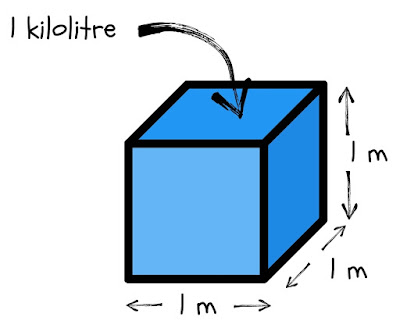Volume Measurements in the Metric System
Volume Measurements in the Metric System
Metric Units of Volume
Volume measures the capacity occupied by liquid, solid, or gas. Let's learn about the units for volume in the Metric System, or essentially, how much space something is taking up in three dimensions. We need to use liquid measuring cups and spoons for basic liquid measurements and conversions. Remember, there are weight measuring cups too, and make sure you use the correct one.
The most significant units of volume in the Metric System of Measurements are,
- liter
- milliliter
- kiloliter
We use these for liquid measurements every single day. Whether we're cooking, gardening, or filling a pool, we have to know the right unit to use. If you're trying to fill a swimming pool, you're probably going to want to use kiloliters more so than you would want to use milliliters. Remember, a milliliter is a small amount, and a kiloliter is quite large. When you're cooking, chances are you're probably going to use milliliters than you are going to use liters unless you're making a large amount of something. Therefore, if you measure the water in the aquarium, you measure it with liters or kiloliters. If you're measuring the amount of soup that you're making is probably milliliters or liters.
You definitely have to know the right unit of volume to use. If you're not careful, you can end up putting too much something into your recipe, and it can lead to a disaster.
You definitely have to know the right unit of volume to use. If you're not careful, you can end up putting too much something into your recipe, and it can lead to a disaster.
The base unit in the metric system for volume is the liter. There are a couple of ways that you can visualize a liter.
Liter
First, you could think about a liter as, a cube that is 10 centimeters deep, 10 centimeters wide, and 10 centimeters tall, the volume is equal to 1 liter.
 |
| volume = 1 liter |
Another way to visualize a liter is to connect it to our everyday lives. You've probably gone and bought, or your parents have bought a 1-liter bottle of something, Oftentimes, it's milk. A liter would be about the size of a milk bottle.
 |
1-liter milk bottle |
Another perfect example to visualize the size of the liter would be the 2 liters soda bottle. Hence, a liter would be about the size of half a soda bottle.
 |
2-liters soda bottle |
And hopefully, both examples would have made sense about the size of the liter relative to above 10 cm x 10 cm x 10 cm cube.
Now, if you want to measure things that are a lot smaller than a liter, the typical unit used in the metric system are the prefixes "deci" and "centi". However, the one that's most typically used is the "milliliter".
Milliliter
The prefix "milli", means 1/1,000 of a liter. Or another way of thinking about it is that 1 liter is equal to 1,000 milliliters.
And, if you wanted to visualize what a milliliter looks like, imagine taking a cube and instead of making it 10 centimeters on each dimension, make it only 1 centimeter in each dimension.
 |
volume = 1 milliliter |
So, if you take a 1 cm wide, 1 cm deep, and 1 cm high cube, you're looking at a milliliter.
If you want to think about the type of things that are measured in milliliters, you might think things
about the dosage of medicine. For example, a typical teaspoon that you might see in your cabinet is going to be a little bit over 4 milliliters, almost 5 milliliters. That might be good for medicine dosage or maybe small ingredients in some type of recipe.
 |
5 milliliters teaspoon |
On the other hand, if you want to go larger than a liter, you could use the other metric prefixes such as dekaliter or hectoliter. However, the one that's most typically used is the "kiloliter".
Kiloliter
As the prefix "kilo" implies, this is equivalent to 1,000 liters.
1 kl = 1000 l
If you want to visualize it, actually it isn't as large as you might assume it to be. If you just take a cube where each dimension is exactly 1 meter, i.e. 1m deep, 1m wide, and 1m tall, this volume is equivalent to a 1 kiloliter.
 |
volume = 1 kiloliter |
So, you could imagine something like a kiloliter would be very useful for measuring. For example, it can be used to measure the volume of water inside a swimming pool.